Bougainvillea spectabilis



Scaly
Scaly bark has a mottled textured and sheds in plates or scales.
Climbing-twining
A plant that climbs using tendrils or twines around a structure.This vigorous twinning climber has slender woody greyish stems with down turning thorns and requires support. The tube-shaped white flowers are accompanied by rich purple bracts and appear in clusters throughout summer.
Bougainvillea spectabilis Willd. is naturally found from Brazil, Bolivia, Peru, and Argentina's Chubut Province in South America growing into trees along forest margins. It prefers a well drained humus rich moist loamy soil that is acidic with a pH range from 5.5 to 6.0. It grows in an open to exposed sunny position and is drought and salt tolerant but frost tender with a preferred minimum winter temperature of 12ºC (55ºF).
Bougainvillea is a vigorous and long lived climber that is grown for summer colour. It is trained over structures (pergolas) for shade or used as a spill-over on embankments. It can be grown on fences and used for screening or planted in pots and tubs. In warmer climates this plant can climb into trees suffocating them and is difficult to remove. Once established it has a medium water requirement, (Scale: 2-drops from 3) and responds to mulching with an occasional deep watering during dry periods.
ID 53
UK hardiness zone H1c
Climate zones 5,6, 12 - 17, 21 - 24
USDA Zone 10-12
Bougainvillea (boo-gan-VIL-lee-uh) spectabilis (speck-TAB-ih-liss)
Etymology
Genus: - Bougainvillea – named after 18th century circumnavigator Louis Antoine de Bouganville
Species; Latin – spectabilis – from ‘spectacular’ referring to the flower bracts
There are many cultivars, please contact your local nursery for available varieties.
Cultivars
'Alba'
This climber is similar to the species and produces white bracts.
'Chili Red'
This vigorous climber has armed woody twining stems with dark green broad-ovate pointed leaves. During early summer it produces masses of flowers that are accompanied with chilli red coloured bracts. It is used for colour contract in a tropical or Mediterranean garden.

'Magnifica'
This climber is similar to the species and produces pink bracts.
'Mary Palmer'
This vigorous climber has long trailing stems and produces pail pink bracts. It is grown over structures or along fences as a screen and tolerates an open sunny position.
'Variegata'
This form is similar to the species but produces green leaves that are blotched in creamy-white.

South America, (Brazil, Bolivia, Peru, Argentina)
Nyctaginaceae (nyk-taj-i-NAY-see-ee)
Bougainvilleas, Four-o'clocks
This family consists of perennials herbs, scrambling shrubs and trees. The species are readily distinguishable by tubular flowers and colourful bracts.
Distribution
This family of plants is found in tropical and sub-tropical regions of the world centring in America. They are commonly found at low altitudes in forests or along beaches and on the adjoining hillsides.
Diagnostic Features
The simple leaves are arranged oppositely, alternate or whorled normally petiolate with stipules absent.
The regular tubular to cup-shape flowers are bisexual or sometimes uni-sexual and occur in corymbs and may be accompanied by colourful calix-like bracts. There are 5 perianth segments that are fused together with the upper part deciduous and the lower persistent around the fruit. There are no petals.
There is one to many but normally 5 stamens that are normally connate at the base with the filaments fused or free. The ovary is superior with one chamber with one erect ovule. The style is simple.
The fruit is a indehiscent achene (nut) and may be enclosed by the persistent calyx base. The seeds are endospermic with a straight or curved embryo.
Note:
There are many colourful cultivars of these species and are cultivated widely in domestic gardens. There are 300 species worldwide with 8 species in Australia.
This plant tolerates between USDA zones 9a to 12a and grows to 15 m ( 49 ft)
Fahrenheit 20º to 55º F
These temperatures represent the lowest average.
Celsius -3.9º to 12.7º C

Attention
The information displayed on this plant is based on research conducted in our horticultural library and from reliable online resources. We also make observations of the plant that we photograph, and all care is taken to ensure the details are correct.
All photographs and data are covered by copyright. Apart from any fair dealing for the purpose of private study, research, reference or review, as permitted under the Copyright Act, no part including images and text may be reproduced by any means without written permission. The information presented in the map is only indicative and may contain errors and omissions. All inquiries should be addressed to sales@plantfile.com attention Peter Kirkland.

Simple
The leaf that is not divided.
Broad ovate
A leaf that is broader than ovate and is broadest at the base tapering towards the apex.
Alternate
Leaves are arranged alternately along the stem.
Entire
A leaf margin with no irregularities (smooth).
Tubulate
A flower that forms a tube shape.
Corymb
An inflorescence that has all flowers brought more or less to a common level.| Jan | Feb | Mar | Apr | May | Jun |
| Jul | Aug | Sep | Oct | Nov | Dec |
The small white flowers are tubulate to salverform and may be tinged in pink. They are arranged in terminal corymbs that are normally inconspicuous amongst the rich purple bracts. There are numerous cultivars with a range of colourful bracts from white, pink, red, crimson, and shades of purple and appear from late spring to mid summer. The collar of the bracts can vary from bud stage to full bloom.

Nut (dim. nutlet)
An indehiscent single locular 1 to 2 seeded fruit. Outer layer (pericarp) has a hard layer."Bougainvillea is a vigorous and long lived climber that is grown for summer colour. It is grown over structures (pergolas) for shade or used as a spill-over on embankments. It can be trained as a screen or grown as a container specimen. In warmer climates this plant can climb into trees suffocating them and is difficult to remove.
Note:
This plant is susceptible to Bacterial Leaf Spot.
Care should be taken to avoid placing this plant close to pedestrian access, as thorns are long and sharp.
Take hardwood cuttings from spring to summer. Take soft tip cuttings during growing period and place in a humid environment.
Asexual Propagation (Cuttings general)
Propagation from cuttings is possible because every cell of a plant containers the genetic information to create an entire plant.
1. Reproduction occurs through the formation of adventitious roots and shoots.
2. The uniting of vegetative parts with budding and grafting.
3. Taking stem cuttings and layering is possible due to the development of adventitious roots
4. Root cuttings can form new shoots then it is possible to join roots and shoots to form a new plant.
5. A new plant may be formed from a single cell in an aseptic culture system, (cloning).
It is important to propagate vegetatively as this form of cloning retains the unique characteristics of the cultivars or where particular aspects of a plant may be lost if propagated by seed.
Equipment Required for Taking Cuttings
1. A sharp knife that is not too large or a razor mounted in a handle.
2. Good pair of sharp secateurs that is clean.
3. A dibbler to make a hole in the media and allow the cutting to be placed in.
4. Propagation structures that are either a timber frame with glass or polyethylene cover or a glasshouse.
The object of the structure is to create an environment where the temperature and humidity can be controlled. This can be achieved with a simple cover over a pot with a wire frame and plastic.
This stops the draughts and maintains humidity.
5. A hotbed is a useful item as many plants root more quickly if the media is slightly warmer.
Bottom heat is obtained from thermostatically controlled heating cables that are running under the media.
6. Misting systems are of great benefit to cuttings as the regulated fogging with water inhibits the cuttings from drying out and as a result the cuttings may be grown in full sun.
This results in faster root development that is less subject to diseases by fungi and bacteria.
7. Rooting mediums
The rooting medium must be well drained, sand may be used as long as it is thoroughly washed and leached of all salts. It is very well drained and it is excellent for cutting that root up quickly. Equal parts of sand and peat moss have good results for cuttings, which are left for a period of time to allow the roots to form.
Vermiculite and perlite are also used as a well-drained rooting media but has the same disadvantage as sand having no nutrients. The cuttings must be potted up as soon as the roots developed, or a light application of liquid fertiliser can be applied.
Types of Cuttings
Stem cuttings
These are the main types of cuttings.
1. Softwood cuttings
These cuttings are taken from young growth on side shoots and tip growth.
2. Semi hardwood cuttings
These cuttings are taken from wood that is firmer and semi ripe usually during mid summer.
3. Hardwood cuttings
These cuttings are taken from mature wood normally towards the end of the season.
4. Root cuttings
Cutting sections of roots to obtain new plants during late winter to early spring.
5. Leaf cuttings
Cutting the leaf blade in order to obtain new plants during the growing period of the plant.
Cutting preparation
Hardwood cuttings
When taking hardwood cuttings remove the leaves and in semi hardwood reduce the number of leaves by half. Cut the wood straight across just below a node or joint. Hardwood cuttings are normally between 100 to 760 mm long and may have either a heel of the older wood attached to the base, or a short section of the older wood at the base. These cuttings are prepared during the dormant season from late autumn to early spring and are made up from previous season's growth.
This type of cutting is used for woody deciduous plants such as Crepe Myrtle, Rose rootstocks and some fruit trees.
The cuttings should be healthy wood with ample supply of stored food as to nourish developing roots, shoots and placed in the rooting media with the aid of a dibbler stick.
Softwood cuttings
The cuttings for softwood should be 60 to 130 mm long and be of material with enough substance as to not deteriorate before the new roots appear. Cut below a node and retain the leaves on the upper portion. Place in a well-drained media and maintain a high humidity.
Soaking the cuttings and leaving them standing in water for long periods is undesirable.
Herbaceous cuttings
These cuttings are taken from succulent plants such as Geraniums and Coleus. The cutting should be 70 to 130 mm long with leaves retained on the upper end. As in softwood cuttings these require an environment of high humidity. Some fleshy cuttings ooze sap and may require a drying period for a few hours before being placed in the rooting media.
Leaf cutting
In these cuttings a leaf blade and petiole or part off is used to raise a new plant. The original leaf doses not become a part of the new plant as roots and shoots appear from the base of the leaf. In some cases roots appear from the severed veins.
Leaf-Bud cuttings
These cuttings incorporate a leaf, petiole and a small piece of the stem. These cuttings are an advantage where the plant uses the axillary bud at the base of the petiole for new shoot growth and maximises available propagation material, as each node will produce a new plant.
As in softwood cuttings these require an environment with high humidity and warmth.
Root cuttings
These cuttings are best taken from younger plants during late winter to early spring prior the new season's growth unless the dormant period is during summer.
Trim the roots as they are dug up, to maintain polarity cut strength at the crown end and a slanted cut at the distal end (away from the crown).
Root cuttings of small plants are placed in flats in lengths of 20 to 50 mm and laying horizontally on the surface of the soil. These may be lightly covered with sieved sand or media, watered and then placing a piece of glass or polyethylene over the container till roots / shoots appear.
Fleshy root cuttings
These cuttings should be 50 to 75 mm long and placed vertically in a well-drained sand media.
Keep the polarity correct and when the roots develop transplant the cuttings into a separate container.
Large root cuttings
These cuttings are 50 to 150 mm long are tied up in bundles and placed in boxes of damp sand, sawdust or peat for about three weeks at a temperature of 4. 5 deg C. When taken out they should be planted in a prepared bed 50 to 80 mm apart with the tops of the cuttings level with or just below the soil level.
PEST
NAME
Two-spotted Mite, Red Spider Mite
Tetranychus urticae
ORDER
Acarina
FAMILY
Tetranychidae
Description of the Pest
Also known as the red spider mite. Females are pale green or yellowish, depending on the host plant, and have two dark lateral markings; the mite becomes red in winter, retaining their dark markings. Nymphs are six-legged, with another pair of legs appearing as the mite matures. Males are smaller and narrower. Fully-grown adults are just visible to the naked eye. Two-spotted mites spread by crawling between nearby plants or movement of dead leaves.
Appearance and Distribution of the Pest
Found world-wide; an introduced pest in Australia. They congregate in protected places, such as under bark and at the base of trees, during winter. During spring, they become green in colour, and migrate back into the leaves. During heavy infestations, the leaves may be covered in visible webs, which they spin as they feed. Leaves may eventually wither and fall. Mites can spread via the movement of dead leaves, or in webs that have become attached to birds or large insects. They initially appear on the undersides of leaves.
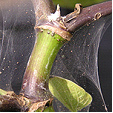
Spruce Spider Mite (Oligonychus ununguis) is a tiny greenish black adult which lays eggs on twigs where they overwinter. The pale green young spiders suck the sap turning the leaves yellow to brown. Heavy infestations form webbing and the pest is found on Abies and Juniperus species.
Banana spider mite (Tetranychus lambi) is a major widespread pest of bananas. It differs from two spotted mite by not producing copious amount of webbing. It is highly active during the dry spring to summer period and with the onset of the wet season mite numbers are reduced. The warm dry conditions that are created under plastic bunch covers is ideal for building up banana spider mite numbers.
Damage is normally confined to the underside of leaves appearing as rusty patches that coalesce along the leaf veins eventually turning the whole leaf brown-grey before it collapses. Fruit is damaged, close to the bunch stalk causing the area to become dull red purple-black, which in turn becomes dry then cracks.
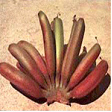 Damage fruit
Damage fruit
Control methods include careful water management during dry periods, and the reduction of dust from roadways. Regular desuckering and leaf trimming of plants will assist with a good coverage when spraying miticides.
Life Cycle
Mites have a gradual metamorphosis, with several nymphal stages. Each female lays up to 100 eggs that hatch in 7-14 days, with several generations appearing throughout the year. Females may become inactive during cold weather.
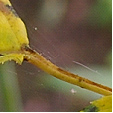 Webbing
Webbing 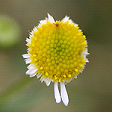
Period of Activity
The Two-spotted mite is most active in hot dry conditions. Under optimum conditions, the population can double every four days. It produces large quantities of webbing for over-wintering nests. Many plants are only susceptible to this insect when cultivated under glass.
Damage Caused
Adults and nymphs lacerated the undersides of the leaves with there rasping mouth parts, although infestations on both surfaces are not uncommon. Infestations cause leaf mottling leaf fall; premature leaf loss causes loss of vigour and reduces the quality and quantity of future crops. Repeated infestations, year after year, may weaken root growth and kill herbaceous plants.
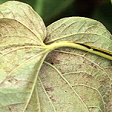
Susceptible Plants
A wide range of plants are attacked by the Red Spider Mite including annuals, fruit trees and vegetables, ornamental shrubs and trees.
Note
Many plant species are more susceptible to Red Spider Mite when they are cultivated under glass.
Other species of mite that are mentioned below have simular characteristics.
Calluna, Rose, Tropaeolum and Viola and species are infested with the Red Spider Mite (Tetranychus telarius) commonly in greenhouse situations.
Musa species are attacked by two spotted mite and banana spider mite damaging foliage and fruit.
Juglans species can be infested with up to four types of mites including red spider.
Cultural Control
Heavy rain or irrigation can reduce numbers; some plants may benefit from replanting in cooler locations. Generally, however, infested material should be completely removed and destroyed.
Preventative measures such as removing weeds or mulching around trees or shrubs or scrubbing the loose bark of susceptible trees during winter helps reduce numbers. During spring sticky bands can be wrapped around trunks close to the ground to trap the mites.
Biological Control
Natural predators include lacewings, ladybirds and thrips help keep the numbers down. Insecticide-resistant predatory mites (Typhlodromus occidenyalis) are also available commercially to control the Two-spotted Mite only on a large scale, as they require ample mites to survive.
Chemical Control
Spraying should be carried out as a last resort as many predators are killed during the operation and spraying can have the opposite effect by increasing numbers in the long term. Dimethoate will reduce numbers; however, Two-spotted mites are resistant to insecticides in some areas. Dusting with wettable sulphur may also prove effective.
Note
Always read the label for registration details and direction of use prior to application of any chemicals.
PEST
NAME
Mealybugs
Various Mealybug Species
ORDER
Hemiptera
FAMILY
Pseudococcidae
Description of the Pest
Adult females are 3-5mm long, flattened oval-shaped white insects, which secrete a white, mealy wax that forms a row of hair-like filaments of fairly uniform length around the edge of the body; the hind end bears one or two pairs of filaments that are longer than the others. They are mobile but slow-moving. The seldom-seen adult males are tiny winged insects with a pair of long waxy tail filaments. Early stage nymphs are tiny, pink and mobile; later stages resemble adult females.
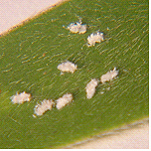
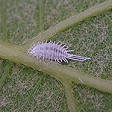
There are many types of mealybugs including;
· Longtailed Mealybugs (Pseudococcus longispinus) generally have tail filaments that are longer than there body. If squashed yellow body fluid is revealed and the eggs are laid under the body and normally hatch immediately.
· Citrus Mealybug (Planococcus citri). This insect has tail filaments that are less than 1/3 the length of its body. It produces yellow orange body fluid and lays eggs in a cottony mass.
· Citrophilous Mealybug ( Pseudococcus calceolariae). This insect has tail filaments that are about 1/3 the length of its body. It produces dark red body fluid and the eggs are laid in a cottony sac.
· Root Mealybug (Rhizeocus falcifer). This insect is not normally seen but produces a open white mass as it feeds on the outer or terminal roots, normally container plants, particularly cacti species. The eggs are laid in the waxy mass and adults may dispersed by ants.
· Hibiscus Mealybug (Maconellicoccus hirsutus)
· Tuber Mealybug (Pseudococcus affinis)
The Mealybugs (Pseudococcus adonidum) and (Planococcus citri) are a major pest of cacti species, sucking sap and turning the infected area yellow. These pests are also found on Strelitzia, Camellia and Yucca species.
Appearance and Distribution of the Pest
Mealy bugs are found worldwide. The above ground species are found in sheltered areas such as under a leaf or in leaf bases. They are also found where two fruits or leaves touch and are not readily noticeable.
The below ground species are only found when a plant is re-potted or the infected plant wilts and dies. Mealybugs are distributed several ways including slowly walking to a new host or transferred on clothing, contaminated plants or strong wind and on visiting insects. They are also farmed by ants which in a nursery situation infest pots by tunnelling and carrying mealybugs to the roots.
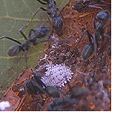 Attending Ants
Attending Ants
Life Cycle
These insects have a Hemimetabolous life cycle, ie. When the immature nymphs resemble the adults.
Up to 200 young are produced in 2-3 weeks; eggs may hatch as they are being laid. The life cycle includes eggs, nymphs (3 to 4 stages) to adult takes 6 weeks, in warmer months; several generations appear throughout the year.
Period of Activity
Active all year, particularly in spring and autumn. Warm, humid conditions are preferred and the insect overwinter outdoors as eggs. These may be found on surrounding weeds. In Citrus species many longtailed mealybugs overwinter as juveniles, maturing during spring. In a Glasshouse conditions mealybugs are active through the year.
Damage Caused
Adults and nymphs suck sap, congregating in sheltered parts of the plants; some species feed undetected on roots. Early infestations may go unnoticed until the plant begins to wilt. The insect also produces honeydew, which gives rise to sooty mould.
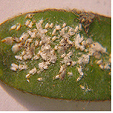
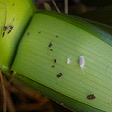 Clivia miniata
Clivia miniata
Susceptible Plants
Mealybugs are found on a wide variety of trees and shrubs. They are also destructive to many ornamentals; including indoor plants (especially African violets and ferns), and are a major greenhouse pest.
Cactus species
Many species of mealybug are common pest of cactus and succulents. The small, grey to light brown mealy bugs are difficult to see amongst the spines. Nesting females appear as the small balls of white fluff on cactus spines or around the base and under the rim of the pots. The female will produce eggs or living nymphs and the insect will produce honeydew that attracts ants. Ants should be discouraged as they farm mealy bugs, moving them from one place to another in a cactus collection.
Cactus is also attacked by the root mealybugs that infest the roots of plants and their damage allows fungal and bacterial infections to enter the plant tissue. They can be identified by white fluffy deposits in the soil or underneath a pot and appeared as tiny pinkish brown wood lice up to 3 mm long.
Catalpa species are susceptible to the mealybug (Pseudococcus comstocki) which is a wax covered mealybug that causes distorted growth of the branches and branchlets.
Fern species are commonly attacked by mealy bugs and can be recognised by small white, waxy secretions as it feeds in the crevices at vein junctions or on the exposed rhizome.
Hedera and Crassula species are susceptible to three species of mealybugs including Citrus Mealybug (Planococcus citri) and not normally requiring control.
Laburnum anagyroides is infested with the Grape Mealybug (Pseudococcus maritimus) infesting the branches and twigs.
Plumeria acutifolia becomes infested with mealybugs on the new growth but normally control is not required.
Psidium species are attacked by the Longtailed Mealybugs (Pseudococcus longispinus).
Sequoia species are attacked by three species of Mealybugs including (Planococcus citri).
Thymus species are attacked by the Root Mealybug (Rhizeocus falcifer).
Thuja species Cupressus macrocarpa and Araucaria heterophylla are can be infested with the mealybugs (Pseudococcus ryani).
Turf Grass may be infested with mealybugs causing severs damage and often go undetected and build up large colonies quickly. The turf forms brown dry patches and looks simular to Dollar Spot the infestation may also occur around core holes and can be discouraged by generous watering. Agrostis palustris (Bent) and Cynodon species (Couch) are commonly attacked.
Yucca species are attacked by the mealybug (Planococcus citri).
Cultural Control
Small plants may be sprayed with a soapy water solution or sponged down preferably during the evening. Heavily infected areas should be pruned and destroyed or the whole plant removed. Infested pot-plants should be discarded and thoroughly disinfect pots before recycling). Maintain vigour by watering to replace sap loss, this helps infected plants to recover.
As a preventative measure for root mealybugs grind up mothballs and add them to the potting mix to discourage infestations. Care should be taken as the chemicals in mothballs can damage plastic pots (use clay pots) and in some countries such as the UK. mothballs must be used as directed on the label.
Biological Control
Lacewing and ladybeetle larvae (Cryptolaemus montrouzeri) control small infestations. This predator insect requires temperatures of at least 21° C. (70°F) and in small infestations it is difficult to maintain a balance between predator and prey.
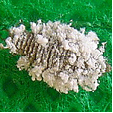
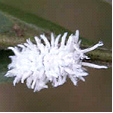
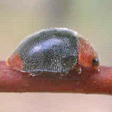
Ladybird beetle larvae eats Mealybugs Ladybird beetle up to 4 mm long
Chemical Control
Spray with white oil may have an effect on the population or spray Omethoate. Contact insecticides are usually ineffective because of the insect's protective waxy coating.
Note
Always read the label for registration details and direction of use prior to application of any chemicals.
PEST
NAME
Whitefly, Snow flies
Various Whitefly Species
ORDER
Hemiptera
FAMILY
Aleyrodidae
Description of the Pest
This is a small sap sucking moth-like insect up to 3mm long with winged adults that have a covering of fine white powder, hence the common name. The wings are folded flat over the body and males live for one month and females live up to three months. The eggs are laid on the underside of the leaf and the wingless nymphs are immobile, flattened-round scale -like with a fringe of waxy filaments. The nymphs are translucent to greenish, congregating on young plant tissue and both adults and nymphs suck sap and producing honeydew.
There are several species such as Ash whitefly (Siphoninus phillyreae), Tobacco whitefly (Bemesia tabaci), Silverleaf whitefly and Spiralling whitefly (Aleurodicus disperses)
Greenhouse whitefly (Trialeurodes vaporariorum)
This species of whitefly normally grow to 2mm long with two pairs of wings. Their colour is due to a covering of a fine white wax and the insect has a white-moth appearance. If disturbed the insects swarm and resettle on the plant quickly. The first nymphal stage is mobile and the later stage is scale-like with fine waxy marginal hairs. These nymphal stages produce honeydew, which encourages sooty mould. It is a persistent pest commonly found in glasshouses.
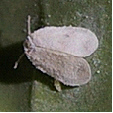 Adult
Adult 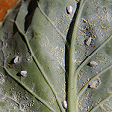 Appearance under the leaf
Appearance under the leaf
The Hakea Whitefly (Synaleurodicus hakeae) is a small, moth-like up to 0.15mm wide with wings that have a powdery coating and produce flattened scale-like nymphs. Both adult and nymph gather together in colonies and suck sap.
Appearance and Distribution of the Pest
The eggs are laid during the spring and the adults tend to stay on the underside of the leaf until disturbed, when they fly in mass and may infect other plants. Many plants are only susceptible to this insect when cultivated under glass.
Life Cycle
This insect has a Hemimetabolous life cycle, ie. When the immature nymphs resemble the adults.
White flies have a gradual metamorphosis, egg and four nymphal stages. One generation occurs from three to eight weeks and is dependant on the current weather. Hundreds of eggs are deposited on the underside of leaves in arch or circles each with a short stalk.
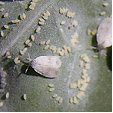 Eggs laid in a pattern
Eggs laid in a pattern 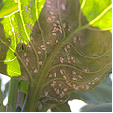 Eggs laid in a pattern
Eggs laid in a pattern
After hatching the first nymphal stage wanders around on the leaf surface for several days. Then selects a place to suck sap where it goes through all nymphal stages emerging as an adult after the fourth stage.
Period of Activity
This peat is found from tropical to temperate regions and is most active during warm weather. It is difficult to predict an infestation, as some years it is severe and other years it is absent. In glasshouse conditions it is often a problem and may extend outside the normal period of activity. They overwinter in the egg stage or find sheltered places to hide.
Damage Caused
Affected plants have leaves with yellowish to white mottling on the upper surface or with shiny secretions on new shoots or on the underside. Heavy infestations cause leaves to wilt and sooty mould to appear on the honeydew. Plant looses vigour and in some cases die.
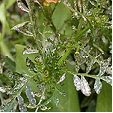
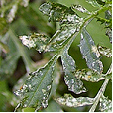 Tagetes erecta
Tagetes erecta
Susceptible Plants
Whiteflies attack a wide range of plants affected by this insect, including Abutilon, Boronia, Hibiscus and Fuchsia species. Citrus, Vegetables, Ferns and certain weed species are venerable. Australian native plants are also attacked, such as the Hakea species.
Greenhouse whitefly (Trialeurodes vaporariorum) attacks a wide range of ornamental plants, weeds and vegetables including; Phaseolus (beans), Lycopersicon (tomatoes), potatoes, Cucumis (cucurbits), Lactuca (lettuce), Dendranthema (Chrysanthemum), Dahlia and Hibiscus species.
Several ferns, including Adiantum, Asplenium, Davallia, Nephrolepis, Onychium, Platycerium and Pteris species are attacked with nymphs congregating on the underside of the fronds, normally causing little damage.
Rhododendron species are attacked by the Rhododendron White Fly (Dialeurodes chittendeni) causing yellowish mottled appearance on the upper surface of the leaf.
Cultural Control
It is difficult to control with out the application of chemicals, though strong jets of water greatly disturb the colonies. Companion plantings with basil or other aromatic plants deters white flies or spray the plants with onion-garlic spray.
In an enclosed environment sticky fly paper can reduce numbers. When the nymphal stage is found an application of white oil will reduce numbers.
Biological Control
A parasitic wasp (Encarsia Formosa) attacks nymphal stages reducing numbers. Other predators include small birds, spiders, ladybirds and there lava, hover flies, damsel flies and mantids.
Chemical Control
Plants may be sprayed with Dimethoate, permethrin, bifenthrin or pirimiphos-methyl, but some insects have immunity to chemicals. The pest may also be sprayed with a mixture of white oil and nicotine sulphate or pyrethrum.
Note
Always read the label for registration details and direction of use prior to application of any chemicals.
PEST
NAME
Scale Insect
Various Scale Species
ORDER
Hemiptera
Description of the Pest
Generally scales are soft bodied insects that have a hard (armoured) or soft covering to hide under. They have piercing and sucking mouth parts that are attached to the host, feed off sap and soft scales commonly producing sweet honeydew, which in turn attracts sooty mould and ants.
The adult female has a circular or oval covering depending on the species and is up to 8mm across. The first stage (crawlers) hatch and wander around the leaf surface until finding a suitable place to suck sap, normally in colonies and the smaller male is relatively inconspicuous.
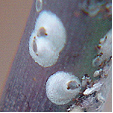 Hard Scale
Hard Scale 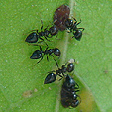 Soft Scale, attending Ants
Soft Scale, attending Ants
Cactus Scale (Diaspis echinocacti) has a circular greyish female and a narrow white male scale and is commonly found on house plants.
Chain Scales (Pulvinaria species) adult females are obvious with large group of eggs that are white or cottony-like, and the tiny young light green scales are flat and oval-shaped up to 2mm long. The legged nymphs are normally arranged from head to tail along the mid rib of the leaf, and may move to a new position to feed. They excrete honeydew and attract sooty mould and are found on Acacia and Acronychia species.
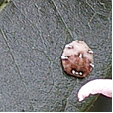 Chinese Wax Scale
Chinese Wax Scale
Chinese Wax Scale (Ceroplastes sinensis) is a domed wax scale that has dark spots around its margin and immature scales form waxy material around there margins.
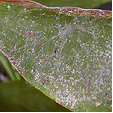 Fern Scale on Aspidistra elatior
Fern Scale on Aspidistra elatior
Fern Scale or Coconut Scale (Pinnaspis aspidistrae) appears as flecks up to 0.15mm long with a white covering over the male congregating on the underside of the fronds on the axils and among the sporangia causing them to turn yellow. Many species of fern are susceptible to infestation.
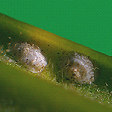
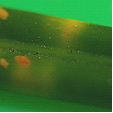 Flat Brown Scale
Flat Brown Scale
Flat Brown Scale (Eucalymnatus tessellates) are light brown up to 0.5mm long, flat and closely attached both sides of the leaf and causing yellowing of the foliage.
Juniper Scale (Diaspis carueli) is tiny and circular, white maturing to grey-black and as it feeds the needles turn yellow and die.
Oleander Scale (Aspidiotus hederae) is a pale yellow circular scale up to 3mm across and is found in dense colonies on the stem or leaves.
Tea-tree Scale (Eriococcus orariensis) are a creamy blue colour normally packed along the branches and are plump and rounded to 4mm across.
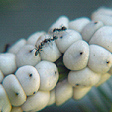
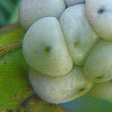 Wattle Tick Scale
Wattle Tick Scale
Tick or Wattle Scale (Cryptes baccatus) adult is domed, blue-slate colour with a leathery covering up to 10mm long. All stages of growth are found in groups of over forty, packed along the stems and normally tended by ants as they produce large amounts of honeydew. A serious pest of Acacia species found inland or coastal from temperate to sub tropical climates and commonly accompanied by Sooty Mould.
Toxic Scale (Hemiberlesia lataniae) is a tiny flat rounded scale up to 0.15mm long and is white to pale pink. It is normally found in colonies on the small branches and twigs of shrubs. It injects a toxic substance into the host as it sucks sap causing the death of the branch.
Wattle Scale (Pseudococcus albizziae) is soft, plump and secrets cotton-like threads. It is not a true scale insect and is simular to mealy bugs. It is reddish-brown up to 0.4mm long and secrets large amounts of honeydew as it sucks sap in colonies along the branches.
Life Cycle
These insects have a Hemimetabolous life cycle, ie. When the immature nymphs resemble the adults.
Appearance of the Pest
All parts of the plant above the soil may be attacked, but normally the stems and leaves and scale tends to favour well-lit positions.
Period of Activity
The nymphs and females are active for most of the year, in warm climates. Once they selected a position they attach and don't move. Normally the winged or wingless males are mobile and only soft scales produce honeydew.
Susceptible Plants
There is a wide range of susceptible plants including citrus, willows, holly, and many ornamentals, such as roses or Paeonia species. It also attacks indoor or glasshouse plants and Australian native plants such as wattles, hakeas, grevilleas and eucalyptus.
Acacia species are attacked by the Tick or Wattle Scale, which infest twigs and small branches and heavy infestations will kill the host plant.
Acer species are attacked by the Cotton Maple Scale (Pulvinaria innumerabilia) which prefers Acer saccharinum. Nymphs first attack the leaves and the brown adult scale is covered in a woolly mass up to 14mm across, normally found on the underside of the stems and twigs.
Acmena smithii, Melaleuca, Syzygium and Pittosporum species are attacked by the Chinese Wax Scale.
Aesculus species are attacked by several scale insects including the Walnut Scale (Aspidiotus juglans-regiae) which is saucer-shaped and attacks the main trunks.
Agave species are susceptible to several types of scale including (Aspidiotus nerii), (Aonidiella aurantii) and (Pinnaspis strachani), but generally do not require control.
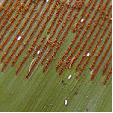 Asplenium australasicum
Asplenium australasicum
Asplenium australasicum is susceptible to Coconut Scale or Fern Scale (Pinnaspis aspidistrae). It is normally found on the under side of the fronds. Small infestations cause little damage.
Bougainvillea species may be attacked by the soft scale (Coccus hesperidum) outdoors or under glass.
Calluna and Vaccinium species are attacked by the Oyster Shell Scale (Lepidosaphes ulmi).
Camellia species may be attacked by the Florida Red Scale (Chrysomphalus aonidum), which is small, circular and black and is found firmly attached to the underside of the leaf along the veins. On inspection after removing the scale the insect has a pale yellow body. Camellias are also attacked by a large variety of scale insects including Tea Scale and Camellia Scale.
Carpinus species may be attacked by the scale (Phenacoccus acericola). It is found on the underside of the leaves forming a white cotton-like clump along the veins.
Casuarina and Allocasuarina species may be attacked by the Casuarina Scale (Frenchia casuarinae), a black hard scale that is upright to 4mm with a pinkish body. During attachment the surrounding tissue swells up and in time can, form galls. This weakens the wood and in severe infestations may kill the tree.
Cotoneaster species are attacked by up to four species of scale including the Oyster Shell Scale (Lepidosaphes ulmi).
Cupressus species are attacked by Bark Scale (Ehrhornia cupressi) is pink and covered in white wax. Heavy infestations cause the leaves to turn yellow or reddish.
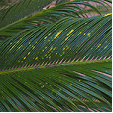 Flat Brown Scale on Cycas revoluta
Flat Brown Scale on Cycas revoluta
Cycads, palms and some species of Callistemon are attacked by the Flat Brown Scale.
Erica species are attacked by several species of scale including, Greedy, Oleander and Oystershell scale.
Jasminum species can be infested with up to twelve types of scale.
Juniperus x media and other conifer species are attacked by the Juniper Scale.
Leptospermum species are attacked by the Tea-tree Scale which produces ample honey dew that promotes sooty mould.
Palm and Fern species are susceptible to attack by the Coconut Scale or Fern Scale (Pinnaspis aspidistrae) which infests the underside of the leaves. They are also hosts for many other scale species such as red, cottony cushion and tea scale.
Pinus species are attacked by several species of scale including the Pine Tortoise Scale (Toumeyella numismaticum) and the Red Pine Scale (Matsucoccus resinosae).
Polygonum odoratum is attacked by a small brown scale.

Sorbus aucuparia is attacked by a five species of scale insect, including Black Cottony Maple, San Jose and Scurfy. Generally they suck on the sap of the new growth and leaves.
Strelitzia species are attacked by the Greedy Scale (Aspidiotus camelliae).
Damage Caused
Leaves become yellow and are shed prematurely and there may be twig or stem die-back. When the infestation occurs on fruit, the fruit is small and its skin becomes pitted and cracked. Small trees and saplings that are heavily infested may be seriously damaged or die. Sooty mould can cover fruit or leaves causing a secondary problem.
Cactus Scale can completely cover the host cactus sucking sap and causing it to die.
Cultural Control
Dead or damaged parts of the plant should be removed and destroyed including fallen fruit. Small infestations may be removed by hand or squashed on the stems. Healthy plants are less susceptible to attack, so maintain vigour of the plant and avoid using high-nitrogen fertiliser that produces excessive soft young growth.
When pruning susceptible plants paint the cuts with antifungal sealant paint as scale insects are attracted to the sweet smell of the sap. This will reduce the infection rate of the plant.
Biological Control
Natural predators such as parasitic wasps may reduce numbers of active nymphs; parasitic wasps are bred commercially in some areas for this purpose. It should be noted, however, that wasps would avoid dusty conditions.
Other predators that assist in control are assassin bugs, ladybirds, lacewings, hover flies and scale eating caterpillars. A variety of birds also attack scales.
The control of ants that transport aphid from one host to another also reduces infestation and can be carried out by applying at least three greased bandages 5mm apart around the stem or trunk of the plant.
Chemical Control
Spray the entire plant with dilute white oil solution; a follow-up spray may be required after four weeks, for heavy infestations. Spraying of chemicals will also kill of natural predators and in some cases the secondary scale infestation is more prolific especially when using copper based chemicals.
Some chemical controls, such as methidathion, are available - please seek advice from your local nursery as to the suitable product for your area.
Note
Always read the label for registration details and direction of use prior to application of any chemicals.
Note: Plants affected by this pest are Deer Resistant plants not the susceptible plants.
PEST
NAME
Deer
Cervus species
ORDER
Artiodactyla
FAMILY
Cervidae

Description of the Pest
There are two species of the deer in North America, the Whitetail (Odocoileus virginianus) and the Mule deer (Odocoileus hemionus) with several regional variations such as the Pacific coastal Blacktail (O.h. columbianus) which is regarded as a sub-species of the Mule deer.
The Whitetail on average grows to 112 cm (44in) tall and 180 mm (70 in) long and weigh 68 kgs (150lbs). The fir colour varies according to its environment but generally it is reddish-brown during summer and grey-brown in winter with a pure white underside on its tail. When the tail is erect it is known as the "white flag". Its antlers consist of two main beams from which the points emerge.
The Mule deer grow to 105 cm (42 in) tall and are up to 200 cm (80 in) long with the adult buck weighing up to 137 kgs (300 lbs) and the does up to 80 kgs (175 lbs). The fir is generally tawny brown during summer and during winter it has a heaver grey-brown to blue-grey coat with a small white tail that is tipped in black. The other distinguishing features are its ears that are up to 300 mm (1 ft) long (mule-like) and its antlers, with the two beams that are forked into smaller beams, which inturn fork again and again.
The Blacktail deer (Pacific coastal Blacktail) grows to 97 cm (38 in) tall and is up to 105 cm (60 in) long and weighs on average 73 kgs (160 lbs). The fir is generally tawny brown during summer and during winter it has a heaver grey-brown to blue-grey coat with a tail that is dark brown at the base then changing to black for 50% of its length. The antlers consist of two beams that are forked into smaller beams, which inturn fork again and again.
Appearance and Distribution of the Pest
The Whitetail deer are found throughout eastern United States, on the coast and inland but are not commonly seen in California, Utah or Nevada. They do not migrate but congregate together (yard up) during winter and feed in a part of their existing territory.
The Mule Deer are found in the western part of North America from South eastern Alaska to Mexico and from the Pacific coast to Texas. They migrate from highland mountain meadows to southern or lower snow free forested valleys during winter.
The Blacktail deer are found on the Pacific coast from Alaska to northern California. There is both resident and migratory Blacktails. The migratory Blacktails move southwards during late autumn at the first sigh of snow or heavy sustained rain and the resident Blacktails seek cover their existing territory amongst woodlands during the winter months.
Life Cycle
All Deer breed from autumn to early winter and the does give birth from late spring to early summer.
Period of Activity
Deer are most active from spring to autumn but can be troublesome during winter when the feed is scarce. In some regions urban landscapes become the major food source both in summer and winter.
Damage Caused
Browsing deer will feed on almost any plant and is most commonly noticeable during spring feeding on the new growth or twigs and stems leaving a shredded appearance. Deer also rub their antlers against trees damaging bark and snapping off small branches, this action also incurs damage under hoof as plants, lawns and garden structures are trampled on.
Susceptible Plants
Some plants are more palatable to deer but when a deer is hungry or during drought conditions there are no "Deer Proof" plants. There is a range of plants that have a bad taste and are not destroyed and are regarded as (deer resistant plants). Deer resistant plants are the plants that are attached to this file not the susceptible plants.
Cultural Control
There are many cultural controls that have been tried to move browsing deer such as frightening them with strobe lights, pyrotechnics or tethered savage dogs. These actions are only temporary and may cause more trouble as the stampeding animals move off. Fencing and netting can be an effective method of discouraging hungry deer from gardens but may be expensive on a large scale and require maintenance. There are several types of fences which include conventional 2.2m (8 ft) deer-proof woven wire fences or single-wire electric fences and slanted deer fences. Plant selection can also be effective, by using less desirable plants (deer resistant plants) as an outer border to the more desirable plant species and thus discouraging the deer to enter the garden. Hedges and windrows of less desirable thorny plants can also be a deterrent to browsing deer.
Chemical Control
There are two main types of repellents contact and area. Contact repellents are applied directly to the plants and deter deer with a bad taste or smell. They can be applied by rubbing or spraying on to the plants and commonly used in an egg mixture. The commercial products have proven to work better than home remedies which include soap or chilli mixtures and hanging bags of human hair.
Area repellents rely on an offensive odour and are placed around areas that are frequently visited.
Contact your local distributor for available types and application.
DISEASE
NAME
Leaf Spot (General)
Various Leaf Spot Species
Description
There is a wide variety of fungal leaf spots that infect perennials, shrub and trees. Some are specific to the host while others can affect a range of plants.
Symptoms
Generally light brown to purplish or blackish spots appear on the leaf and form concentric rings of fruiting bodies. The spots may leave holes, perforating the leaf or expand with pale green to yellowish margins and when the holes merge the leaf normally dies. There are many different types of leaf spot, some are discussed below.
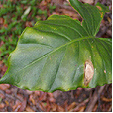 Alocasia species
Alocasia species 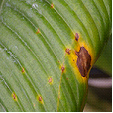
Alternaria Leaf Spot (Alternaria nelumbii) forms a small reddish brown spots that are boarded in light green, and as they develop in size the leaf curls and dies from the margin inwards. Normally occurs on Nelumbo species (water lilies).
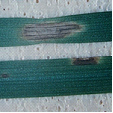 Helminthosporium Disease
Helminthosporium Disease
Helminthosporium Disease (Bipolris species), (Drechslera species) and (Exserophilum species) are responsible for several leaf spots that occur on all Turf Grass species. Generally they form black or white spots that may be faded and produce masses of spores in the thatch during late summer, under humid conditions. The life cycle is short and when conditions are favourable spores are splashed onto the foliage from the thatch, causing wide spread infection. Cynodon dactylon (common couch) is most susceptible and found in bowling or golf greens where it is a serious problem.
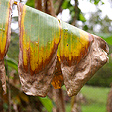 Banana Leaf Spot
Banana Leaf Spot 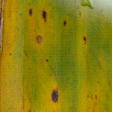
Banana Leaf Spot (Mycosphaerella musicola) is found on many species of banana causing pale yellow streaks on the young leaves to turn brown with dark spots. The leaf then becomes dried, brown and dead commencing from the margins, eventually the leaf dies. Control requires removal of infected foliage or the spraying of a fungicide and fungicides should not be used during the fruiting period.

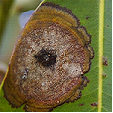 Lophostemon confertus (Brush Box)
Lophostemon confertus (Brush Box)
Leaf Spot on Brush Box (Elsinoe species). This is a casual fungus that attacks the epidermal layer of the leaf, forming circular spots that are up to 25mm across and are often restricted by the main vein. These spots are a dull yellowish brown but can also have purplish patterns. A leaf may have more than one spot develop on its surface and normally appears on scattered leaves throughout the tree. This doesn't affect the vigour of Lophostemon confertus.
Palm Leaf-scab (Graphiola phoeicis) appears as yellow spots and develop into scabs or warts that are outwards hard and dark but with a soft centre with powdery yellowish brown spores. The infected leaves eventually die.
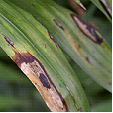 Palm Leaf Spot, Chamaedorea elegans
Palm Leaf Spot, Chamaedorea elegans
Palm Leaf Spot (Pestaloptiopsis species) appears as a small spot with a dark centre on the leaves and affects palms that are growing in shaded humid positions and normally control is not required, though infected fronds should be removed.
Source and Dispersal
Infection source is other contaminated plants and the spores are spread by wind or by splashing water. The fruiting bodies are black spots that appear on the damaged tissue releasing spores.
Favoured Conditions
This fungus prefers a warm humid environment and leafy plants with soft new growth, particularly if they are crowded.
Affected Plants
There are many ornamental and native plants that are hosts to a wide range of fungal leaf spots. Some specific ones are listed below. Plants such as Cornus or Paeonia species are infected by a large variety of leaf spots, while other plants attract a specific leaf spot.
Generally a healthy plant can tolerate fungal leaf spot attack, though it may make the plant look unsightly. In trees and shrubs it is difficult to control and generally not necessary, but in perennials and annuals control may be necessary in order to save the plant.
Acalypha and Arctotis species are infected by up to three leaf spots including (Cercospora acalyphae) and (Ramularia acalyphae) that rarely require control.
Acer species are infected by Purple Eye (Phyllosticta minima) which forms spots with brownish centres and purplish margins causing the death of the leaves.
Acer species are also infected by Tar Spot (Rhytisma acerinum) which forms round black spots that have yellow margins. Not normally seen on cultivated trees, but seen in forests.
Adiantum, Asplenium, Blechnum, Cyathea, Davallia, Nephrolepis, Platycerium, Polypodium and Pteris species are infected by the leaf spot (Pseudocercopora species) which forms circular brown spots on the fronds and heavy infection can defoliate a plant.
Aesculus species are occasionally infected with the leaf spot (Septoria hippocastani) which forms small brown spots.
Agave species are susceptible to the leaf spot (Coniothyrium concentricum), which appear as greyish spots up to 20mm (1in) across with concentric rings and black fruiting bodies. Affected leaves are destroyed as the infection spreads.
Albizia julibrissin is susceptible to the fungal leaf spot (gloeosporium aletridis), which does not normally require control.
Amelanchler, Chaenomeles, Crataegus and Rhaphiolepis species Mespilus germanica are infected by the leaf spot (Fabraea maculata) which may cause considerable damage during wet periods.
Aquilegia species can be infected by three types of Leaf Spot including (Ascochyta aquilegiae), (Cercospora aquilegiae) and (Septoria aquilegiae), normally appearing during humid conditions forming spots on the leaves.
Arbutus species are infected by two leaf spots (Septoria Unedonis) which produces small brown spots on the leaves and (Elsinoe mattirolianum).
Arctostaphylos manzanita is infected by the leave spot (Cryptostictis arbuti) which damages leaves but is not normally detrimental to the shrub.
Aspidistra species are infected by the leaf spot (Colletotrichum omnivorum) causing whitish spots on the leaves and petiole.
Aster species are infected by many leaf spots including (Alternaria species), (Cercosporella cana), ( Ovularia asteris) and (Septoria asteris).
Aucuba species are infected by several leaf spots, usually as a secondary infection after aphid attack. These include (Phyllosticta aucubae) and (Phyllostica aucubae).
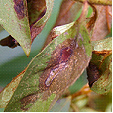
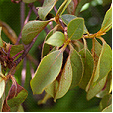 Azalea
Azalea
Azalea (Rhododendron species) are susceptible to Leaf Scorch (Septoria azalea). This fungal disease forms reddish- brown spots which expand and engulf the leaf, with fruiting bodies appearing in the centre. Infected leaves die, then fall and the branchlets wilt. This problem is more serious during wet periods and may require control using a fungicide.
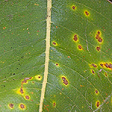 Banksia robur
Banksia robur
Banksia species are infected by several leaf spots causing chlorotic areas that have brown centres and is not normally a major problem for the plant.
Betula species may be infected by the Leaf Spots (Gloeosporium betularum) that forms brown spots with darker margins and (Cylindrosporium betulae) that also forms brown spots with faded indefinite margins.
Bougainvillea species are infected by the leaf spot (Cercosporidium bougainvilleae) which forms rounded spots with dark margins that yellowish ting. Infected leaves die and fall from the plant.
Calendula species are infected by the Leaf Spot (Cercospora calendulae) which rapidly infects the plant spotting the leaves and killing the plant.
Callicarpa species may be infected by the leaf spot (Atractilina callicarpae) forming irregular brownish spot or (Cercospora callicarpae) which can defoliate the plant in subtropical climates.
Campsis species may be infected by several fungal leaf spots including (Phyllosticta tecomae), (Septoria tecomae) and (Cercospora duplicata).
Carpinus species are infected by the leaf spots (Gloeosporium robergei), (Gnomoniella fimbriata) and (Septoria carpinea), all are minor infections not normally requiring control.
Carya species are infected by several leaf spots including (Gnomonia caryae) that infects leaves with irregular reddish spots on the upper surface with corresponding brown spore producing spots on the underside. It also has a secondary spore release that occurs on the dead leaves where it over winters. Other leaf spots include (monochaetia desmazierii) and (Marssonina juglandis).
Ceanothus species are susceptible to the leaf spot (Cercospora ceanothi) and (Phyllosticta ceanothi) both are of minor importance not requiring control.
Celtis species are infected by many leaf spots including (Cercosporella celtidis), (Cylindrosporium celtidis), (Phleospora celtidis) and (Septogloeum celtidis).
Chrysanthemums species are infected by the leaf spot (Septoria species) which forms yellow spots appear toward the edge of the leaves; these become enlarged brownish patches with yellow margins. Damaged areas may converge and in severe attacks and the leaves may fall prematurely or flower production is reduced.
Clematis species are infected by the fungal disease (Ascochyta clematidina) which may cause stem rot or leaf spots that are water soaked areas with reddish margins. The infection spreads from the leaves to the stem causing wilting and eventually girdling the stem killing the plant. There are many fungal leaf spots that infect this plant including (Cercospora rubigo) and (Septoria clematidis)
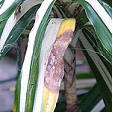 Dracaena deremensis
Dracaena deremensis
Cordyline and Dracaena species may be infected by the leaf spot (Phyllosticta maculicola) which forms small brownish spots that have yellowish margins and has black fruiting bodies that forms coils of spores. These plants are also susceptible to other leaf spots such as (Glomerella cincta) and (Phyllosticta dracaaaenae). Keep foliage dry to avoid infection.
Cynodon dactylon, Pennisetum clandestinum and many other Turf Grasses are susceptible to Helminthosporium Disease.
Daphne species are infected by the leaf spot (Gloeosporium mezerei) and (Marssonina daphnes) both of which form thickish brown spots that are seen on both sides of the leaves. Infected leaves turn yellowish before dieing.
Dendranthema species are infected by many leaf spots such as (Septoria chrysanthemi) which first forms yellowish spots up to 25mm (1in) across that become black. Infected leaves die prematurely and persist on the plant.
Dianthus species may be infected by the leaf spot (Septoria dianthi). It forms light brown rounded spots that have a purplish border. The scattered spots on the lower leaves can also be found on the stems and the spores are dispersed by water from the tiny black fruiting bodies.
Dieffenbachia species are infected by several leaf spot fungi including (Cephalosporium species) and (Myrothecium species).
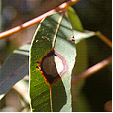 Eucalyptus species
Eucalyptus species
Eucalyptus species are infected by many fungal leaf spots such as (Mycosphaeralla species), (Hendersonia species) and (Monocheatia monochaeta). Generally leaf spots appear on the juvenile or new leaves causing brownish spots that enlarge and may have a purplish halo around the margin. Mature adult leaves are not normally infected and the trees rarely require control measures.
Fern species are infected by the leaf spot, (Alternaria polypodii). This fungus appears as brown circular or oblong spots that congregate along the margins of the pinnae causing the fronds to turn brown and die. It is spread by wind currents from plant to plant and control methods include removing infected fronds and maintaining a drier atmosphere.
Ficus species are infected by various fungal leaf spot including (Pseudocercospora species). Generally the fungal attack forms circular or irregular dark coloured spots on the leaves eventually causing them to fall prematurely.
Ficus elastica is susceptible to many fungal leaf spots including (Alternaria species), (Leptostromella elastica) and (Phyllosticta roberti).
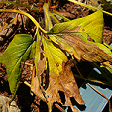
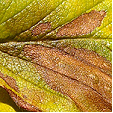 Strawberry
Strawberry
Fragaria x ananassa (Strawberry) is infected by the fungal leaf spot (Mycospharella fragariae). The mature leaf is initially infected with well defined brown spots that that turn light grey with red-purplish margins. As the spots merge they form large brown blotches and the leaf turns yellow then dies. This fungal attack normally occurs on plants in poor health and can be a serious problem early in the season seriously damaging stock.
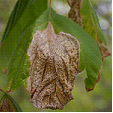 Fraxinus species
Fraxinus species
Fraxinus species are infected by the leaf spot (Gloeosporium aridum) giving the leaf a scorched appearance as large blotches appear from the margin or apex and turn brown with a papery texture. It is more prevalent during rainy periods and infected leaves fall prematurely. Collect and depose of fallen leaves otherwise control is not normally required.
Fuchsia species may be infected by the leaf spot (Septoria species) or ( Cercospora species), both form spots with dead centres and dark margins.
Gladiolus species are infected by Hard Rot or Leaf Spot (Septoria gladioli). On the corms reddish brown circular water soaked spots become large and sunken. These areas dry out and form obvious margins. The leaves may also have these symptoms but is not commonly seen.
Hemerocallis species are infected by several leaf spots including (Cercospora hemerocallis) and (Heterosporium iridis). These may be in the form of black spots or brownish spots that converge killing the leaf. Infected leaves should be removed and burnt.
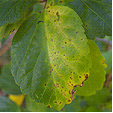 Hibiscus species
Hibiscus species
Hibiscus rosa-sinensis, Hibiscus syriacus and Hibiscus tiliaceus are susceptible to several fungal leaf spots including (Ascochyta abelmoschi), (Cerospora kellermanii) and (Phyllosticta hibiscina). All cause spotting or blotching of the leaf surface; remove and destroy infected parts.
Hydrangea species are infected by four fungal species including (Ascochyta hydrangeae), (Phyllosticta hydrangeae) and (Septoria hydrangeae).
Iris species are infected by several fungal leaf spots including (Alternaria iridicola) and (Macosphaerella species).
Iris species are also infected by the leaf spot (Didymellina macrospore) that forms greyish spots with brown water soaked borders and coalesce on the upper part of the leaf. This casual organism commonly occurs after flowering killing the leaves but will not infect the bulbs. The bulbs become weak over several seasons due to the decreased foliage.
There is also a Bacterial Leaf Spot (Bacterium tardicrescens) that is commonly mistaken as a fungal problem causing translucent spots that coalesce and involve the entire leaf. Normally found on Iris species.
Laburnum anagyroides is infected by the Leaf Spot (Phyllosticta cytisii). The leaf forms light grey spots with no definite margin and mature to brown. The black fruiting bodies appear as dots in the centre of the spot.
Leucanthemum species are infected by the leaf spot (Cerocspora chrysanthemi) and (Septoria leucanthemi).
Magnolia species are susceptible to many species including (Alternaria tenuis), (Mycosphaerella milleri) and (Phyllosticta species). Leaves generally turn brown from the apex or margins turning brown or spots appear on the leaf surface and leaves become yellow before withering and dieing. Normally the make the tree look poorly but have little effect on its growth. Control is not normally required.
Nerium oleander is susceptible to several fungal leaf spots including (Cercospora nerella), (Cercospora repens), (Gloesporium species) and (Phyllosticta nerii). Infected leaves should be removed but generally control is not required.
Nyssa sylvatica is infected by the leaf spot (Mycosphaerella nyssaecola) forming irregular purplish blotches.
Orchids such as Cattleya, Cymbidium, Cypripedium, Dendrobium, Epidendrum, Paphiopedilum, Phalaenopsis and Zygopetalum species are infected by several leaf spots including (Cerospora, Colletotrichum and Phyllosticta species). Normally forming dark or dead, circular or irregular areas on the leaves.
Palms such as Syagrus, Howea, Phoenix, Roystonea and Washingtonia species are infected by Leaf-scab (Graphiola phoeicis).
Palms such as Archontophoenix, Caryota, Chamaedorea, Cocos, Dypsis, Howea, Liculia, Linospadix, Livistona, Phoenix, Ptychosperma, Rhapis, Roystonea, Syagrus, Washingtonia and Wodyetia species are susceptible to several fungal leaf spots including;
(Bipolaris spp.), (Cylindrocladium spp.), (Colletotrichum spp.) and (Pestalotiopsis spp.).
Generally the circular leaf spots are brown and may have a yellow halo such as Palm Ring Spot (Bipolaris incurvata). They vary in size from small to large depending on the species. When a plant is healthy it recovers from attack, but heavy infections can defoliate, causing the collapse of the plant.
Palms are also infected by the Brachybasidium Leaf Spot (Brachybasidium pinangae). This fungus forms angular leaf lesions that produce fruiting bodies on the underside and is commonly found on Archontophoenix species.
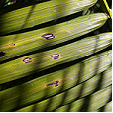
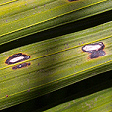 Archontophoenix cunninghamiana
Archontophoenix cunninghamiana
Passiflora species are infected with many types of leaf spot such as (Alternaria passiflorae).
Phoenix species are susceptible to False Smut (Graphiola phoenicis). This fungus forms yellow leaf spots that become hard with a raised with a blackish scab, which produces masses of powdery spores that are thread-like.
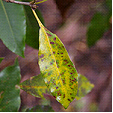
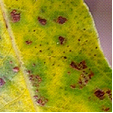 Pittosporum species
Pittosporum species
Pittosporum species are susceptible to the leaf spots (Alternaria tenuissima), (Phyllostica species) and (Cercospora pittospori). Circular or angular dark spots appear on the leaves and are surrounded by necrotic areas that are yellowish. Generally removal of infected leaves is adequate control.
Poa species and other cool season grasses are infected by Winter Fusarium Leaf Disease (Fusarium species), which causes small pale spots that are water soaked to appear on the leaves that turn red-brown. Infected leaves become bleached then wither and die, but the infection will not affect the crown or roots of the plant. It can be identified by pink, cotton-like mycelium and the plant prefers cold wet weather.
Populus species are infected by several fungal leaf spots including (Ciborinia bifrons, Ciborinia confundens), and (Mycosphaerella populicola).
Prunus species are infected by several leaf spots including (Cercospora circumscissa and Septoria ravenelii).
Pseudotsuga menziesii Douglas Fir is infected by the Leaf Cast (Rhabdocline pseudotsugae) Symptoms include the needles becoming yellowish at the apex and extending down the needle and spreading to others during moist spring weather turning them brown. Brownish scorched areas are noticeable on the tree from a distance. Control; is not normally required for mature trees but nursery stock may require spraying with a copper based fungicide.
Psidium guajava (Guava) is infected by (Glomerella cingulate). This fungus courses spots to appear on leaves and mummifies and blackens immature fruit or rots mature fruit. This fungus can devastate a guava crop.
Quercus species are infected by several types of leaf spot including (Cylindrosporium microspilum) and (Marssonina martini). These attacks tend top take place later in the season and normally not detrimental to the tree.
Rhododendron species are infected by a large variety of fungal leaf spots including (Cercospora rhododendri) and (lophodermium melaleucum)
Salix species are infected by several fungal leaf spots including (Ascochyta salicis) and (Septogloeum salicinum).
Senecio species are infected by the fungal leaf spot (Alternaria cinerariae) and (Cercospora species), forming dark rounded or angular spots.
Spiraea species are attacked by the fungal leaf spot (Cylindrosporium filipendulae).
Stenotaphrum secundatum (Buffalo) turf grass is susceptible to Grey Leaf Spot (Pyricularia grisea) in domestic and commercial situations devastating lawns. This fungal disease infects the stems and leaves with small brown lesions that enlarge rapidly forming grey-brown spots that have darker borders or surrounded by yellow chlorotic areas. This infection is commonly found on newly laid turf but will also infect established lawns. It is most prevalent during warm humid periods in soil with a high nitrogen level.
Syringa species are attacked by up to six species of leaf spot including (Cercospora lilacis) and (Phyllostica species).
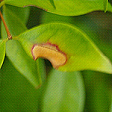 Syzygium species
Syzygium species
Syzygium species are infected by fungal leaf spots but normally control is not required.
Tagetes species are infected by the leaf spot (Septoria tageticola), which starts at the base and moves progressively up through the plant, covering the leaves in grey to black spots.
Trillium species are host to several leaf spots, including (Colletotrichum peckii) (Gloeosporium Trillii) (Heterosporium trillii).
Ulmus species are infected by many fungal leaf spots including (Gnomonia ulmea) and (Cercospora sphaeriaeformis).
Veronica species are infected by the leaf spot (Septoria veronicae). The symptoms include small violet to brown spots appear on the upper surface of the leaf and correspondingly yellowish brown on the underside. The spots converge forming a scorched shot-hole appearance and eventually death of the leaf.
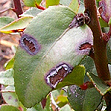 Vaccinium ovatum
Vaccinium ovatum
Vaccinium ovatum is infected by the leaf spot (Rhytisma vaccinii) and (Dothichiza caroliniana).
Vicia species are infected by the leaf spot (Erostrotheca multiformis), which forms greyish spots that enlarge and may defoliate the plant.
Wisteria species are infected by three fungal leaf spots (Phyllostica wisteriae), (Septoria wisteriae) and (Phomatospora wisteriae).
Non-chemical Control
Remove and destroy infected plant material and avoid overhead watering. When planting select infection resistant varieties. Practice crop rotation and add pot ash to the soil to decrease the plants venerability to the disease. Many species of fungus overwinter in fallen leaves, remove and destroy any litter under the plant.
Winter Fusarium Leaf Disease in Turf Grasses can be minimised by aerating the soil, reducing thatch and avoid excessive nitrogen in the soil.
Chemical Control
Protective fungicides such as zineb or copper oxychloride should be sprayed at the first sign of infection and cuttings should be sprayed as they start to grow.
Note
Always read the label for registration details and direction of use prior to application of any chemicals.
DISEASE
NAME
Bacterial Rot
Various Bacterial Species
Description
Bacterial problem associated with water soaked strips on the leaves, stem, roots, fruit or flower. Bacterial wilts produce causative slime that clogs the water-conductive tissue of a plant.
Symptoms
Bacterial Blight (Pseudomonas mori) forms water soaked spots on the leaves and shoots, becoming sunken and turning black causing the leaves and twigs to wilt and die.
There is also a Bacterial Blight (Pseudomonas syringae pv pisi) that infects legumes during humid weather with water soaked spots on the leaves and stems near the base. The spots become dark and as the stem shrivels, yellow lesions appear. Leaves and fruit pods turn brown and die.
Bacterial Leaf Spot (Pseudomonas viburni) forms wet spots that enlarge becoming brown and sunken. These spots can be seen on the leaves and young stems and the bacteria overwinter in buds or in cankers. It is found on Viburnum species.
Bacterial Wilt (Xanthomonas species) infects palms causing the lower fronds to wilt then turn grey-brown and die. This is followed by the crown becoming spongy (rotted) attacking the vascular tissues and eventually causing the collapse of the crown. There is also a Bacterial Leaf Spot (Xanthomonas species) that causes spots on leaves with water-soaked margins and is found on Alocasia species.
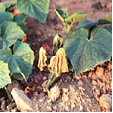 Bacterial Wilt
Bacterial Wilt
Bacterial Wilt (Pseudomonas solancearum biovar 1 and 3). This disease initially turns the youngest leaves pail-green to yellow; they then wilt turn brown and die. It eventually affects the entire plant and is found on Heliconia species.
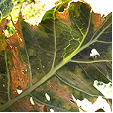
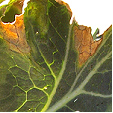 Black Rot or Bacterial Wilt
Black Rot or Bacterial Wilt
Black Rot or Bacterial Wilt (Xanthomonas campestris) is a bacteria rot that infects the leaves and seedlings of Cruciferous vegetables causing 'V' shaped pale yellow blotches to appear, normally infection occurs along the margin of the leaf or through damaged areas of the leaf. It also causes the flower head to become stunted and the veins or water conducting tubes in the leaves and stems to turn brown or blackish. Heavy infections cause the plant to wilt and die.
Bud Rot (Xanthomonas cannae) infects young leaves and flower buds of Canna species, killing them. Small whitish spots appear as the leaves or buds open, these enlarge then run together turning black. The symptoms also extend to the petioles and stems forming yellowish water soaked areas and the bacterium overwinters in the rhizomes.
Halo Blight of Beans (Pseudomonas syringae pv phaseolicola) forms water soaked or greasy angular spots on the pods or stems of the host. This causes the plants to yellow and become stunted. During humid weather a white slime is exuded from the damaged areas.
Soft Rot (Pecotbacterium carotovorum) affects bulbs, initially stops flowers from blooming or forming correctly. These flowers are shed, and the plant rots at the base causing it to collapse. On inspection of the bulbs a white foul smelling viscous smell is associated with a soft rot.
Wetwood (Erwinia nimipressuralis) causes wilting and branch dieback in Ulmus species. The wood forms dark water soaked areas with no obvious streaking in the outer sapwood.
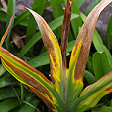 Yellow Rot in Iris
Yellow Rot in Iris
Yellow Rot (Xanthomonas hyacinthi) is a bacterial disease infects the cell walls of the leaf, stem and bulbs and caused yellowish water soaked areas to appear. These areas become brown and shrivel, or pockets of rot appear, soon engulfing the entire bulb. The disease may start from the leaf down or from the bulb up infecting the whole plant. A cross section reveals vascular tissue that is choked with yellowish slime. Infected plants soon brown off, collapse and die.
Source and Dispersal
The bacterium is found in infected plant material and not necessarily the soil and is spread by splashing water, wind or infected stock.
Favoured Conditions
It prefers warm moist conditions normally during spring.
Affected Plants
These bacteria attack many plants including; onions, Hyacinth species and its varieties, this can be a major problem in bulb nurseries.
Vegetables such as potatoes are also infected by blight which forms dark brownish spots on the leaves that become larger, eventually killing them and followed by lesions on the stems. The roots are infected by falling spores and peas suffer from a bacterial blight that forms spongy leaves with dark brown edges. The leaves and stem shrivel and die.
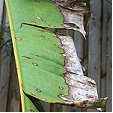 Strelitzia nicolai
Strelitzia nicolai
Archontophoenix and Strelitzia species are susceptible to the Bacterial Wilt (Pseudomonas solanacearum). The leaves become yellowish and brownish along the margins causes the fronds to wilt and dry out. The vascular tissue in the stems then becomes blackish and the plant dies prematurely.
Berberis species are infected by the Bacterial Leaf Spot (Pseudomonas berberidis) forming irregular dark green water soaked areas that turn purplish brown. It also infects young shoots and petioles or damaged areas.
Bougainvillea and Limonium species are infected by the Bacterial Leaf Spot (Pseudomonas andropogonis) which forms orange angular spots that are lighter in the centre and cause the leaves to fall prematurely. It is most common in tropical regions.
Caryota mitis (Clumping Fish Tail Palm) is infected by the Bacterial Blight (Pseudomonas avenea). The symptoms include water soaked translucent areas along the leaf veins that mature to brown then black with a chlorotic halo that is up to 2 mm wide by 50 mm long. Leaves of all ages are infected and immature leaves are more severely infected.
Control methods include eliminating overhead watering, removing infected foliage and improve air circulation around the plant.
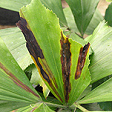 Caryota mitis
Caryota mitis
Cheiranthus species and other plants in the Brassicaceae family are infected by the Bacterial Wilt (Xanthomonas campertris) causing the leaves to wilt, turn yellow and die. It also stunts the inflorescence and turns the phloem and xylem blackish. Other plants that are infected include, Arabis, Armoracia, Aubrieta, Brassica, Hesperis, Iberis, Lobularia and Mathiola species.
Corylus species are infected by Blight ((Xanthomonas corylina) that attacks the leaves and branches.
Delphinium species are infected by several leaf spots including the bacterial disease Black Leaf Spot (Pseudomonas delphinii) which produces irregular tar-like spots on the upper surface of the leaf with corresponding brownish areas on the underside. This infection may extent down the petiole to the twigs. It normally occurs during cool weather affecting the lower leaves first.
Dianthus species are infected by the Bacterial Wilt (Pseudomonas caryophylli) which turns the leaves greyish, then yellowish before dieing. Yellowish streaks are also seen on the stems.
Dieffenbachia species are infected by two Bacterial Leaf Spots (Erwinia species) and (Xanthomonas campestris pv. dieffenbachiae). Both form yellowish spots that turn brown on the leaves that have water-soaked margins.
Eschscholtzia species are infected bt the Bacterial Blight (Xanthomonas papavericola) which forms tiny black spots that are water soaked and may be ringed.
Euphorbia pulcherrima is infected by Bacterial Canker (Corynebacterium poinsettiae) which forms streaks on the green stems that are water-soaked. The leaves may also be affected producing spots or blotches.
Gladiolus, Crocus and Freesia species are susceptible to Bacterial Scab (Pseudomonas marginata). This disease attacks the corms by forming slightly raised yellowish lesions that develops a raised rim with a soft sunken centre, producing bacterial exudate. It also infects the leaves with small reddish spots appearing towards the lower part. These spots merge and destroy the basic cell structure (parenchyma tissue) in the petioles causing the leaves to fold downwards, eventually killing the plant.
Hedera helix is susceptible to the Bacterial Leaf Spot or Stem Canker (Xanthomonas hederae). This infection commences with pale green water soaked spots or areas appearing on the leaves. These areas than become brown-black and dry with reddish margins, eventually engulfing the leaf causing it to shrivel. The bacterium then extends along the twigs and into the stems causing cankers. Several Fungal leaf spots develop simular symptoms and may be difficult to distinguish the difference. Generally avoid high humid temperatures and water plants at the base.
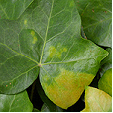
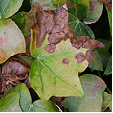
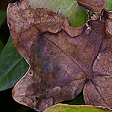 Hedera helix
Hedera helix
Morus species are infected by Bacterial Blight (Pseudomonas mori).
Orchids such as Cattleya, Cymbidium, Cypripedium, Dendrobium, Epidendrum, Oncidium, Paphiopedilum, Phalaenopsis and Zygopetalum species are infected by Bacterial Brown Rot (Pseudomonas cattleya) which forms water-soaked leaf spots that turn brown. Phalaenopsis species are particularly susceptible.
Caryota species are susceptible to Bacterial Leaf Blight (Pseudomonas albopercipitans). This disease forms elongated water soaked areas on the fronds that are translucent at first becoming blackish.
Roystonea regia, Cocos nucifera and Phaseolus species are infected by Bacterial Wilt (Xanthomonas species).
Tropaeolum species are infected by Bacterial Leaf Spot (Pseudomonas aptata) forming spots and rotting the leaves. They are also infected by the Bacterial Wilt (Pseudomonas solanacearum) which gains access through damaged roots or through the stomates, causing yellowing, wilting and the death of the plant.
Zinnia species are attacked by Bacterial Wilt (Pseudomonas solanacearum).
Non-chemical Control
Remove and destroy any infected plants. As a preventive measure cultivate the surrounding soil to improve drainage, aeration and minimise weed growth. Do not over water and allow the soil surface to dry before rewatering. When handling the plants pick a dry period and take care to minimise damage.
At first sigh of infection the plant should be removed and disposed off and avoid replanting susceptible vegetables such as peas for up to three years.
Chemical Control
There is no satisfactory chemical control. It is important to take preventive measures.
Note
Always read the label for registration details and direction of use prior to application of any chemicals.
Average Lowest Temperature : -1º C 30º F
USDA : 9, 10, 11, 12
This USDA (United States Department of Agriculture) hardiness zone chart can be used to indicate a plant’s ability to withstand average minimum temperatures. However, other factors such as soil type, pH, and moisture, drainage, humidity and exposure to sun and wind will also have a direct effect on your plant’s survival. Use this chart only as a guide, always keep the other factors in mind when deciding where, when and what to plant.
A plant's individual USDA zone can be found in the Plant Overview.
Region of origin
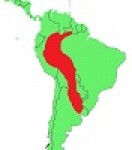
South America, (Brazil, Bolivia, Peru, Argentina)
Climate Description
Warm to Sub-tropical
This overlaping zone has ample rain with high summer temeperatures and high humidity. Winters are mild. Pockets of sub-tropical climates exist within coastal warm temperate zones.
Frosts and droughts rarely occur along the coast.
Plant growth
Tropical and warm temperate native and exotic plants grow well.
| Dictionary | Growth Habit |
| Leaf Type | Botanic Flower Description |
| Leaf Shape | Flower Inflorescence |
| Leaf Arrangement | Fruit Type |
| Leaf Margin | Bark Type |
| Leaf Apex And Bases | Flower Description |